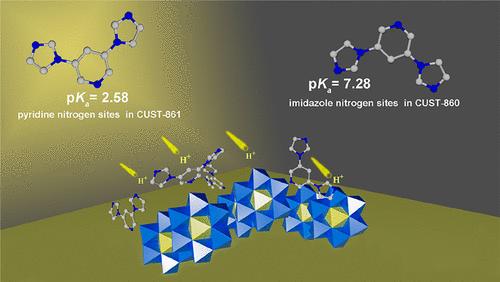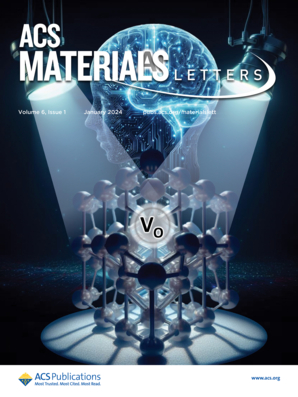迅速释放质子增强基于安德森-多氧金属盐的金属有机框架的质子传导性
IF 9.6
1区 化学
Q1 MATERIALS SCIENCE, MULTIDISCIPLINARY
引用次数: 0
摘要
在固态质子导体中迅速释放质子可以提高质子传导性。通过将安德森型 POMs(TeMo6)、3,5-双(咪唑基)酰胺和[Co3(Bip)2(H2O)10(TeMo6O24)](CUST-861)结合在一起,制备出了两种新的基于聚氧化金属盐的金属有机框架(POMOFs)、是通过水热法将安德森型聚甲醛(TeMo6)、3,5-双(咪唑-1-基)吡啶(Bips)和过渡金属离子结合在一起制得的。粉末 X 射线衍射(PXRD)和热重分析(TGA)等相关测试表明,这两种化合物都具有出色的热稳定性和水稳定性。交流阻抗测试表明,在 90 °C 和 98% 相对湿度(RH)条件下,CUST-861 的最高质子电导率为 2.96 × 10-2 S cm-1,比 CUST-860 高出 3 个数量级。此外,理论计算的结果表明,CUST-861 中配体的非配位吡啶氮位点的 pKa 值低于 CUST-860 中配体的非配位咪唑氮位点的 pKa 值,从而更有利于质子传输。这项研究为基于 POMs 的固体质子导体的合成提供了启示。本文章由计算机程序翻译,如有差异,请以英文原文为准。

Swift Proton Release Enhancing Proton Conductivity in Anderson-Polyoxometalates-Based Metal–Organic Frameworks
Swift proton release in solid-state proton conductors can enhance the proton conductivity. Two new polyoxometalates-based metal–organic frameworks (POMOFs), [Cu2(HBip)2(H2O)6(TeMo6O24)] (CUST-860) and [Co3(Bip)2(H2O)10(TeMo6O24)] (CUST-861), have been fabricated via combining Anderson-type POMs (TeMo6), 3,5-bis(imidazole-1-yl)pyridines (Bips), and transition metal ions under hydrothermal method. The related tests such as powder X-ray diffraction (PXRD) and thermogravimetric analysis (TGA) indicated that both compounds exhibit excellent thermal stabilities and water stabilities. Alternating current (AC) impedance tests showed that the highest proton conductivity of CUST-861 was 2.96 × 10–2 S cm–1 under 90 °C and 98% relative humidity (RH), which is 3 orders of magnitude higher than CUST-860. Furthermore, theoretical calculation results indicated that the uncoordinated pyridine nitrogen sites of ligands in CUST-861 have a lower pKa value than the uncoordinated imidazole nitrogen sites of ligands in CUST-860, which is more conductive to proton transfer. This study provides insights into the synthesis of solid proton conductors based on POMs.
求助全文
通过发布文献求助,成功后即可免费获取论文全文。
去求助
来源期刊

ACS Materials Letters
MATERIALS SCIENCE, MULTIDISCIPLINARY-
CiteScore
14.60
自引率
3.50%
发文量
261
期刊介绍:
ACS Materials Letters is a journal that publishes high-quality and urgent papers at the forefront of fundamental and applied research in the field of materials science. It aims to bridge the gap between materials and other disciplines such as chemistry, engineering, and biology. The journal encourages multidisciplinary and innovative research that addresses global challenges. Papers submitted to ACS Materials Letters should clearly demonstrate the need for rapid disclosure of key results. The journal is interested in various areas including the design, synthesis, characterization, and evaluation of emerging materials, understanding the relationships between structure, property, and performance, as well as developing materials for applications in energy, environment, biomedical, electronics, and catalysis. The journal has a 2-year impact factor of 11.4 and is dedicated to publishing transformative materials research with fast processing times. The editors and staff of ACS Materials Letters actively participate in major scientific conferences and engage closely with readers and authors. The journal also maintains an active presence on social media to provide authors with greater visibility.
 求助内容:
求助内容: 应助结果提醒方式:
应助结果提醒方式:


